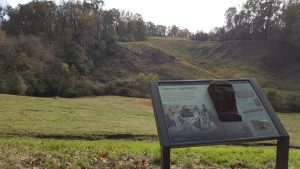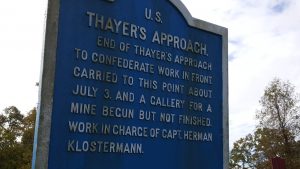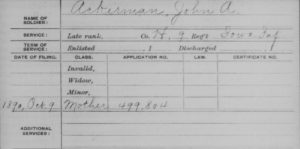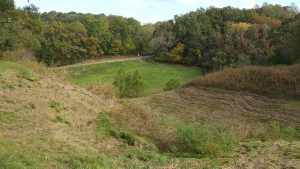Research – It’s the Journey, Not the Destination
Emerging Civil War welcomes back guest author Sheritta Bitikofer…
Sometimes, I have a bad habit of reverse researching a person or a topic, and it tends to take me on a wild goose chase. There are times I stumble upon pure historical gold, and other times when I come up with absolutely nothing. But, I’ve learned to enjoy the process and maintain an attitude of learning.

A couple of years ago, I wanted to write a flash-fiction story about visiting a battlefield and seeing a “ghost.” Forgive my ignorance and wild imagination. I had just begun studying the Civil War and the fanciful idea wouldn’t leave me alone until I wrote it down. We had recently visited Vicksburg and walked the entirety of the park in two days, which allowed me to appreciate the hilly terrain and explore the tour stops more deeply than we might have if we were driving. I was drawn to Thayer’s Approach where Brigadier General John M. Thayer led his men in two unsuccessful assaults against the Confederate line on May 19th and May 22nd, 1863. Afterward, they excavated a tunnel in the ridgeline, both for protection and in order to carve out a safe approach to the enemy so as to dig a mine and blow it up, as what happened at the Third Louisiana Redan. I could imagine the boys in blue digging night and day, working in teams to cut through the landscape. So, I decided to write about a soldier who was stationed along that portion of the Union line and had died in Vicksburg.
Searching through the muster rolls, I decided upon Private John A. Ackerman of the 9th Iowa Infantry, Company H. His story stood out even more, as his service record reads, “Wounded slightly in right hand May 20, 1863, Vicksburg, Miss. Died of wounds July 6, 1863.” [1] Ackerman suffered a slight wound sometime between the two assaults in May, and then later died of said wounds. It’s not all too surprising, considering the high mortality rate for soldiers whose wounds had become infected. Did Ackerman not receive adequate medical treatment? Or did he try to keep the wound clean, but such a task was nearly impossible when he might have been part of the digging crew for the trenches leading to the Confederate line? Either way, Ackerman was buried in the Vicksburg National Military Cemetery. [2]

Recently, my husband and I took another trip to Vicksburg for a tour of Chickasaw Bayou and Champion Hill, hosted by Dr. Timothy Smith. After the amazing and epic trek that weekend, I decided that I wanted to visit John Ackerman’s grave, as well as journey back to Thayer’s Approach to gain a better perspective. We made the wise decision not to walk the driving tour this time.
However, due to the unstable terrain that the Vicksburg battlefield is infamous for, North Union Avenue was closed to cars and pedestrians. Thayer’ Approach landed smack-dab in the middle of North Union Avenue, so we settled for getting a view from the Confederate side. Several blue signs dotted the slope leading down to North Union Avenue and Tour Stop #6, but I could read none of them from the safety of the parking area. I hoped that perhaps one of these signs would be a marker for the 9th Iowa Infantry and I could stand where Ackerman might have been. I carefully trekked my way to each sign, finding no trace of the 9th Iowa. I did, however, reach the high watermark of the Union’s advance to the Confederate line.

Thankfully, we could still visit the cemetery and according to Ackerman’s records, his remains were laid to rest in Section G, grave 1249. Though we had no map of the cemetery on hand, Google became our ally. We came to Section G, only to find graves numbering in the 4000 and 5000 range. We circled and weaved through the headstones, trying to deduce any sort of pattern that might lead us to Ackerman. We soon realized that grave 1249 was not in Section G. It was located in Section C or A and belonged to a Michigan soldier. To say we were utterly confused would be putting it lightly. Thinking there might have been a typo in the records somehow, we rearranged the numbers of his supposed marker to just about every combination possible and continued looking. We climbed up and down those terraced sections, sweating despite the chilly November afternoon, and Mississippi soil staining our clothes.
After what felt like hours and with no Ackerman found, I was about ready to give up. Sitting on a couple of headstones – my apologies to their occupants – we took a short break to reassess. My husband played a game on his phone while I turned to the internet for help. I pulled up his record again to make triple sure that I had written it down correctly. I had, and I found a couple of other sources that affirmed his grave marker as 1249. Then, I had the idea to search the Vicksburg National Military Cemetery on Find-A-Grave. While not always reliable, I had become desperate. I found Ackerman fairly quickly. Low and behold, I was given another grave number. Section G, grave 5575. [3] Evidently, the grave numbering system had changed over the years. That number sounded far more accurate and I knew exactly where the mid-5000s were located in Section G – we had passed it at least three times! I hopped up, slapped my husband’s knee and took off running with this new lead. It took less than a few minutes to finally find John A. Ackerman of the 9th Iowa Infantry, Company H. I collapsed beside his headstone, far more relieved and excited than what should have been reasonable. After all, I didn’t know much about him by that point. However, I felt committed to learning more.

It took all my self-control not to jump on my laptop as soon we came home late that night and begin searching for more information about Ackerman. When I finally set aside a few hours to conduct my search, I was severely disappointed. I hoped the search would be easy, given that I knew his death date and a likely place of residence. While I found some information about a John Ackerman, it feels inconclusive. Dozens of tabs littered my browser as I pursued each possible lead, searching well into the night to find any definitive record of John Ackerman of Iowa. What I’ve settled on is the closest and far more likely of the profiles available
If my sources are correct, John Ackerman might have been born in Ohio in 1836 to David and Electa Ackerman, both hailing from New York. [4] That would make him about 27 at the time of his death in Vicksburg. Ironically, that was my age at the time we found his grave. The farming family had moved to Millford, Indiana by 1840 and John was the third eldest of seven siblings. By 1860, the family had relocated to Sheridan Michigan, but John was no longer with them. [5] It’s unclear where he went, if he was married, where he worked, or anything prior to his enlistment on August 21, 1861. His record lists him as a resident of Decorah, Iowa. He was mustered into the 9th Iowa Infantry alongside 977 other men. They took a steamboat to the Benton Barracks in St. Louis where they were given their equipment and drilled until October, when they then traveled to Franklin, Missouri and stayed for three miserable months, suffering from inclement weather. The regiment would later participate in several small engagements in the western theater and a few larger battles, including Pea Ridge in early March of 1862, and the campaign leading up to Vicksburg in 1863. The 9th Iowa Infantry would lose 121 men during the siege that ended with the surrender of Pemberton’s Confederate forces. [6]

The Ackerman family scattered after the war, but a few members of the family, including John’s father and younger brother, were buried in West Clarendon Cemetery in Clarendon, Michigan. Among the family plot is a cenotaph dedicated to John, but no picture exists online. [7] John’s mother submitted a pension application on October 9th, 1890, but I’ve been unable to track down any approval or rejection of the application. [8]
It’s much less than I hoped to find. After all the hiking, the searching, and the imagining I had done in order to paint a full picture of John A. Ackerman of the 9th Iowa, I wanted something more substantial. A picture, an occupation, maybe even a letter or two. After the initial disappointment faded, I realized that the end of any research endeavor may not always be satisfying. Yes, it was a lot of hard work to find him and discover these few bits and pieces of his story, but that’s what makes the research meaningful. I now can appreciate the effort of the men who dug the trenches and tunnels along Thayer’s Approach – that hill is steep, y’all. And, if I should ever need to find another soldier in the Vicksburg National Military Cemetery, I’ll be more careful to find the most recent grave marker number associated with that soldier. Also, with each trip to the census records, I hone those searching skills so that I’ll know how to avoid dead-ends and rabbit holes, ultimately speeding up the process for future research. Perhaps most important of all, John Ackerman’s story – though still shrouded in mystery – can be told. In the end, isn’t that what historians strive for? To shine a spotlight upon these characters of the past and improve our understanding of their lives and experiences, however grand or humble they may be.
Sheritta Bitikofer is a lifelong student of history with a specific interest in the Civil War era. Along with being a wife, historical fiction author, and fur-mama of two, she is an active member of the Mobile and Pensacola Civil War Roundtables and currently pursuing a bachelors degree in US History at American Public University. She also manages her own modest Civil War blog where she writes about her studies and many travels to battlefields and other historic sites.
Footnotes:
[1] Roster and record of Iowa soldiers in the War of the Rebellion : together with historical sketches of volunteer organizations, 1861-1866; v. 02, written by Iowa Adjutant General’s Office, William H. Thrift, published Des Moines, Iowa : E. H. English, 1908-1911; Page 17
[2] Quartermaster General’s Office. Roll of Honor. Names of Soldiers Who Died in Defence of the American Union. Volumes VIII-XXVII. Washington, D.C.: Government Printing Office, 1867.
[3] National Cemetery Administration. U.S., Veterans’ Gravesites, ca.1775-2019 [database on-line]. Provo, UT, USA: Ancestry.com Operations Inc, 2006.
[4] Seventh Census of the United States, 1850; (National Archives Microfilm Publication M432, 1009 rolls); Records of the Bureau of the Census, Record Group 29; National Archives, Washington, D.C
[5] 1860 U.S. census, population schedules. NARA microfilm publication M593, 1,761 rolls. Washington, D.C.: National Archives and Records Administration, n.d.
[6] HISTORICAL SKETCH NINETH REGIMENT IOWA VOLUNTEER INFANTRY; Iowa in the Civil War, http://iagenweb.org/civilwar/books/logan/mil401.htm
[7] Find a Grave, database and images (https://www.findagrave.com : accessed 14 February 2021), memorial page for John A. Ackerman (unknown–9 Jul 1863), Find a Grave Memorial no. 17378764, citing West Clarendon Cemetery, Clarendon, Calhoun County, Michigan, USA ; Maintained by Frank Passic, Albion Historian (contributor 46564182) .
[8] Organization Index to Pension Files of Veterans Who Served Between 1861 and 1900, compiled 1949 – 1949, documenting the period 1861 – 1942, Roll T289, Catalog ID 25

As another writer of 19th century historical fiction, I sympathize with your trips down the research rabbit holes. You so want to have facts on which to hang your story. Sometimes, as you found, the people we would like to know better have been lost to the shadows of time. But thanks for writing about your experience. You are a very diligent researcher.
I did a similar research journey with my ancestor in the 82 Ohio. Thanks for this article.
For more information, you would need to go to the National Archives in DC. They should have his service record, medical record, and information from the Pension Bureau – on whether they approved the pension application for his mother.